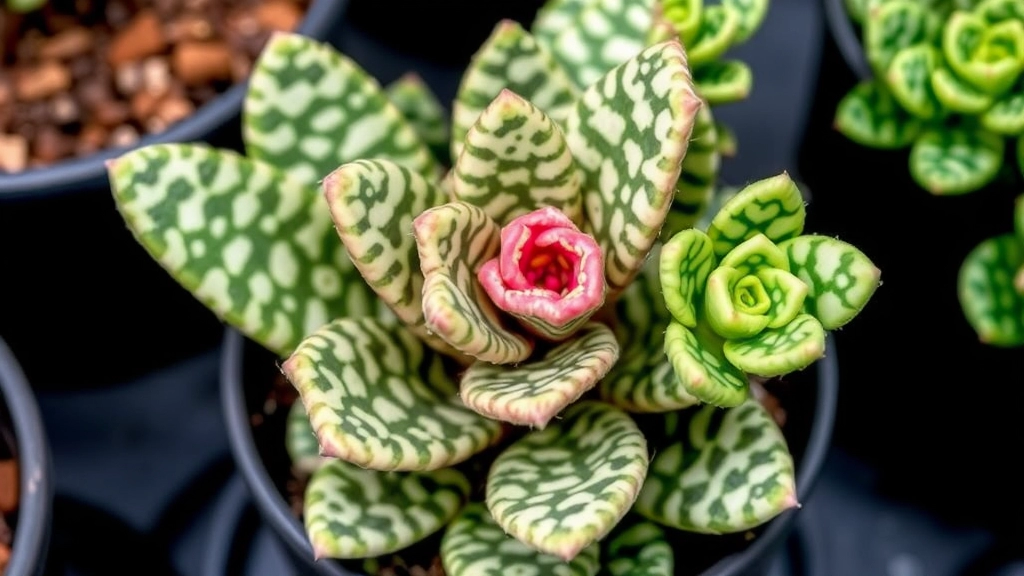Leopard Mother Of Thousands: An Introduction
If you’re looking to cultivate a unique and eye-catching plant, the Leopard Mother Of Thousands, also known as Kalanchoe Daigremontiana or Alligator Plant, might be just what you need. This fascinating succulent is not only easy to care for but also adds a touch of exotic beauty to any garden or indoor space.
Guide to Growing and Maintaining Your Plant
In this guide, I’ll walk you through the essentials of growing and maintaining your Leopard Mother Of Thousands. From choosing the right soil to understanding its watering needs, you’ll learn everything necessary to keep your Alligator Plant thriving.
### Overview of Kalanchoe Daigremontiana
Are you curious about a unique plant that can brighten up your living space while being relatively low-maintenance?
Kalanchoe Daigremontiana, commonly known as the Alligator Plant or Mother of Thousands, is a fascinating succulent that has captured the interest of many plant enthusiasts.
This hardy perennial is renowned for its distinctive appearance and remarkable growth habits.
#### Key Characteristics
– **Leaf Structure**: The leaves are thick, fleshy, and have a serrated edge, resembling the skin of an alligatorâhence the name.
– **Propagation**: One of its most intriguing features is its ability to produce small plantlets along the edges of its leaves, allowing it to propagate easily. For a detailed guide, check out our [step-by-step guide for Kalanchoe leaf propagation](https://planthq.org/kalanchoe-leaf-propagation-stepbystep-guide-for-success/).
– **Growth Habit**: Kalanchoe Daigremontiana can reach heights of up to 1 meter, making it a striking addition to any collection. If you’re interested in comprehensive care tips, our [complete care guide for Kalanchoe Daigremontiana](https://planthq.org/complete-care-guide-for-kalanchoe-daigremontiana-pink-butterflies/) is a must-read.
Common Names and Variations

Now that we’ve got an overview of Kalanchoe Daigremontiana, let’s dive into the names and variations that this fascinating plant goes by.
You might know it better as the Alligator Plant or the Mother of Thousands.
These names are pretty descriptive, right?
- Alligator Plant: This name comes from the unique, jagged leaves that resemble an alligator’s skin.
- Mother of Thousands: It’s called this because of its ability to produce countless tiny plantlets along the edges of its leaves.
But did you know it also has a few other nicknames?
- Chandelier Plant
- Leopard Plant
- Bryophyllum Daigremontianum (its scientific name)
Each name reflects a different aspect of its appearance or growth habit.
These variations might confuse you at first, but they all point to the same resilient plant.
Unique Features of the Alligator Plant
As we delve deeper into the fascinating world of Kalanchoe Daigremontiana, also known as the Alligator Plant, it’s essential to highlight its unique characteristics that set it apart from other houseplants.
The Alligator Plant is renowned for its striking appearance and remarkable adaptability. Here are some standout features:
- Distinctive Leaves: The leaves are thick, fleshy, and serrated, resembling an alligator’s skin, which is how it gets its common name. They can grow up to 30 cm long and have a vibrant green hue, often displaying a slight reddish tint at the edges.
- Offsets: One of the most intriguing aspects of Kalanchoe Daigremontiana is its ability to produce numerous offsets, or “pups,” along the edges of its leaves. This trait not only contributes to its visual appeal but also makes propagation a breeze.
- Flowering: When provided with the right conditions, the Alligator Plant can produce clusters of tubular flowers. These blooms are usually a vibrant pink or red and can attract pollinators, adding another layer of beauty to your indoor garden. For more on achieving optimal blooms, check out this guide.
- Resilience: This plant is exceptionally hardy. It can thrive in various environments, making it a perfect choice for both novice and experienced gardeners. Its ability to store water in its leaves allows it to withstand periods of drought.
Ideal Growing Conditions
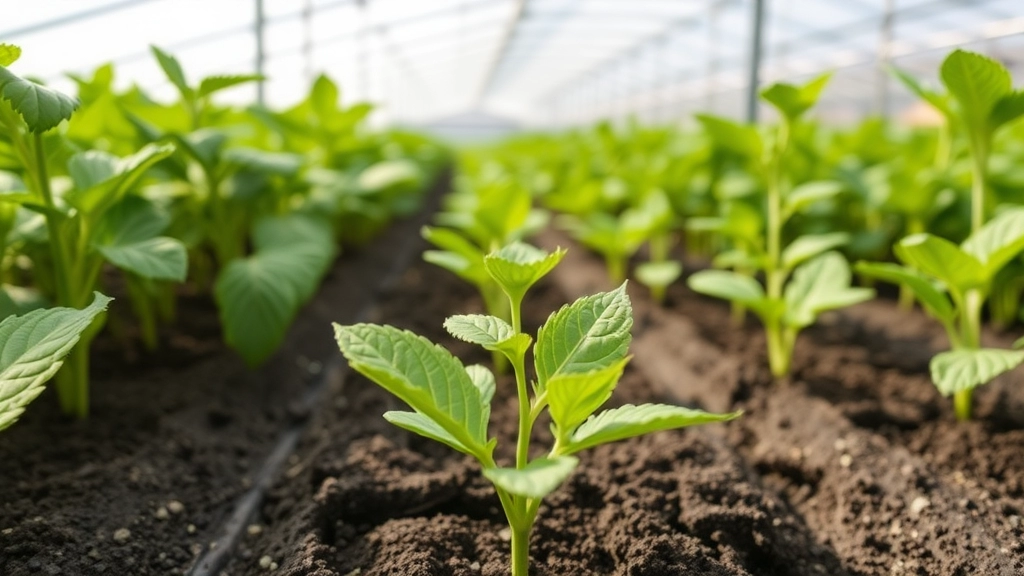
When considering how to cultivate Kalanchoe Daigremontiana, also known as the Alligator Plant, understanding its ideal growing conditions is essential. Many plant enthusiasts often wonder what environment best supports this unique succulent.
Light Requirements
Kalanchoe Daigremontiana thrives in bright, indirect sunlight.
- Optimal Placement: A south or west-facing window is ideal.
- Avoid Direct Sun: Too much direct sunlight can scorch the leaves.
Temperature Preferences
This resilient plant prefers a warm environment.
- Ideal Range: Temperatures between 20°C to 30°C (68°F to 86°F) are perfect.
- Cold Sensitivity: Protect it from temperatures below 10°C (50°F) to prevent damage.
Humidity Levels
Kalanchoe Daigremontiana is not particularly fussy about humidity.
- Low Humidity: It adapts well to dry indoor conditions.
- Avoid Excess Moisture: High humidity can lead to rot.
Soil Type
Choosing the right soil is crucial for the health of your Alligator Plant.
- Well-Draining Soil: A cactus or succulent mix is ideal.
- pH Level: Aim for a slightly acidic to neutral pH (6.0 to 7.0).
Container Choice
The right pot can make a significant difference.
- Drainage Holes: Ensure your container has drainage holes to prevent water accumulation.
- Size Matters: A pot that allows for growth without being too large is best.
Propagation Techniques
Are you eager to expand your collection of Kalanchoe Daigremontiana?
Propagation is not only simple but also incredibly rewarding.
Here’s how you can easily propagate your Alligator Plant:
Watering and Soil Requirements
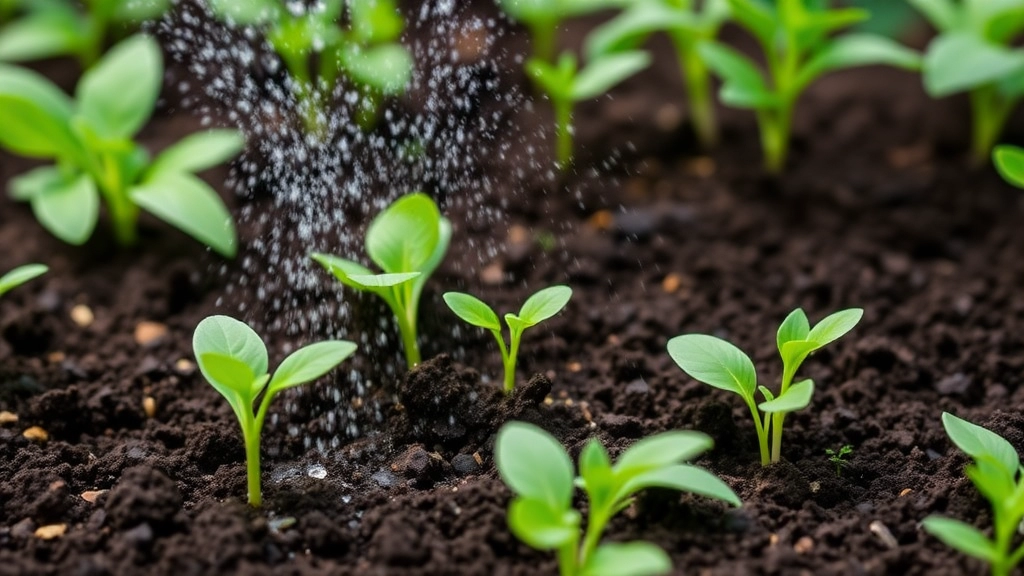
So, you’ve got your Kalanchoe Daigremontiana, and you’re probably wondering just how much water it needs and what kind of soil is best.
Let’s dive in.
When it comes to watering, the Alligator Plant is pretty forgiving, but that doesn’t mean you can neglect it. Here are some straightforward tips:
- Watering Frequency: Aim to water every 2-3 weeks during the growing season (spring and summer). In winter, cut back to once a month.
- Check the Soil: Always check if the top inch of the soil is dry before watering again. If it’s still moist, hold off a bit longer.
- Signs of Overwatering: Yellowing leaves or mushy stems? That’s a red flag. You might be giving it too much love!
Now, let’s talk soil. The right soil can make a world of difference:
- Well-Draining Soil: Use a cactus or succulent mix. This helps prevent root rot, which is a common issue for these plants.
- DIY Mix: If you’re feeling crafty, mix regular potting soil with sand or perlite to enhance drainage.
- Pot Choice: Opt for pots with drainage holes. This ensures excess water escapes, keeping your plant happy.
By keeping an eye on your watering routine and using the right soil, your Kalanchoe Daigremontiana will thrive.
Light and Temperature Preferences
Understanding the light and temperature preferences of Kalanchoe Daigremontiana, commonly known as the Alligator Plant, is crucial for its successful growth. Many plant enthusiasts often worry about providing the right conditions for their indoor and outdoor plants.
Light Requirements:
- Bright Indirect Light: The Alligator Plant thrives in bright, indirect sunlight. For more detailed information, you can check out the optimal light for Kalanchoe guide.
- Avoid Direct Sunlight: While it can tolerate some direct sun, prolonged exposure can scorch the leaves.
- Artificial Light: If natural light is limited, consider using grow lights to supplement.
Temperature Preferences:
- Ideal Temperature Range: This hardy succulent prefers temperatures between 18°C to 24°C (65°F to 75°F). To understand the best conditions, refer to this optimal Kalanchoe temperature guide.
- Cold Sensitivity: It is sensitive to frost and should be protected from temperatures below 10°C (50°F).
- Indoor vs. Outdoor: If grown indoors, ensure it is placed away from drafts and heating vents.
Common Pests and Diseases
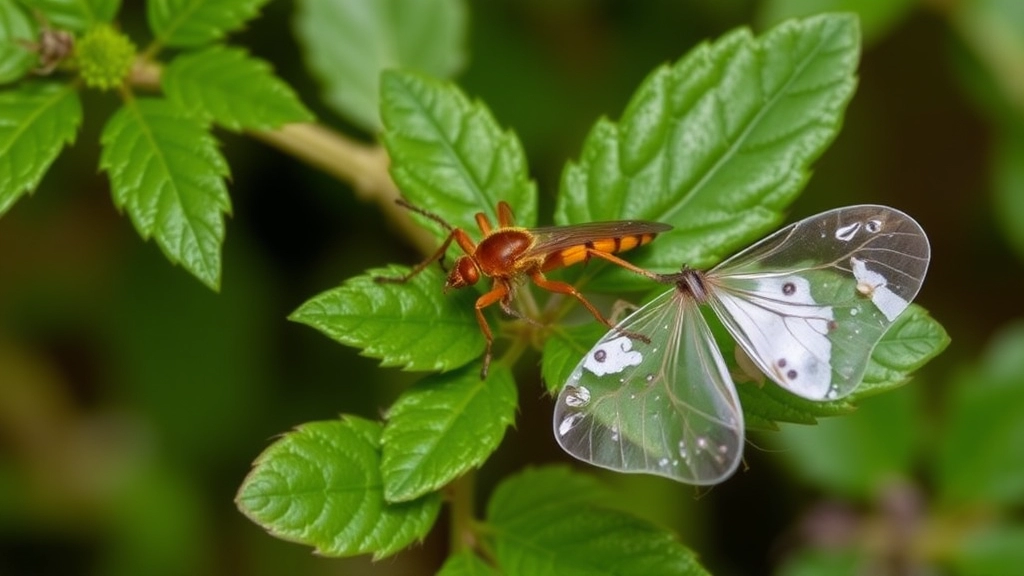
So, you’re enjoying your Kalanchoe Daigremontiana, but suddenly, you notice something off.
What do you do when pests or diseases come knocking on your plant’s door?
Let’s dive into the common culprits that might try to invade your lovely Alligator Plant.
Common Pests
- Mealybugs
– These tiny, white, cotton-like pests love to hide in the leaf joints.
– They suck the sap, causing leaves to yellow and drop.
– Tip: Dab them with a cotton swab soaked in rubbing alcohol. - Aphids
– Small, green or black insects that cluster on new growth.
– They can stunt your plant’s growth and attract ants.
– Tip: A strong spray of water can knock them off. - Spider Mites
– Tiny and often go unnoticed until you see fine webbing.
– They thrive in dry conditions and can cause leaf discoloration.
– Tip: Increase humidity or mist your plant regularly. - Scale Insects
– Look like tiny bumps on stems and leaves.
– They can be hard to spot but can lead to serious damage.
– Tip: Use insecticidal soap for an effective treatment.
Common Diseases
- Root Rot
– Caused by overwatering, root rot can be a sneaky killer.
– Symptoms include wilting leaves and a mushy stem.
– Tip: Always check your soil moisture before watering. - Powdery Mildew
– A white, powdery fungus that appears on leaves.
– It thrives in high humidity and poor air circulation.
– Tip: Improve airflow and avoid overhead watering. - Leaf Spot
– Dark spots on leaves can indicate fungal infections.
– This can be exacerbated by wet leaves.
– Tip: Remove affected leaves and ensure proper spacing.
Prevention Tips
- Regular Inspections:
Check your plant weekly for signs of pests or diseases. - Good Airflow:
Ensure your plant isn’t cramped to reduce humidity around it. - Healthy Soil:
Use well-draining soil to prevent root issues.
When considering the allure of Kalanchoe Daigremontiana, also known as the Alligator Plant, many enthusiasts may overlook an important aspect: its potential toxicity.
### Understanding Toxicity
Kalanchoe Daigremontiana contains compounds that can be harmful to pets and humans if ingested.
**Symptoms of Toxicity:**
– Vomiting
– Diarrhoea
– Lethargy
– Heart irregularities
### Safety Precautions
To ensure a safe environment while enjoying this beautiful plant, consider the following precautions:
– **Placement:** Keep the plant out of reach of pets and small children.
– **Education:** Inform family members and guests about the plant’s toxicity.
– **Emergency Plan:** Have contact information for a local poison control centre readily available.
For more detailed information on the safety of handling Kalanchoe plants, you can refer to our guide on [Kalanchoe Poisonous to Touch: Safety Tips and Risks](https://planthq.org/is-kalanchoe-poisonous-to-touch-safety-tips-and-risks/). Additionally, if you’re interested in the unique characteristics of this plant, check out our [Leopard Mother of Thousands Care Guide](https://planthq.org/leopard-mother-of-thousands-care-for-alligator-plant/).
Benefits of Growing Leopard Mother Of Thousands
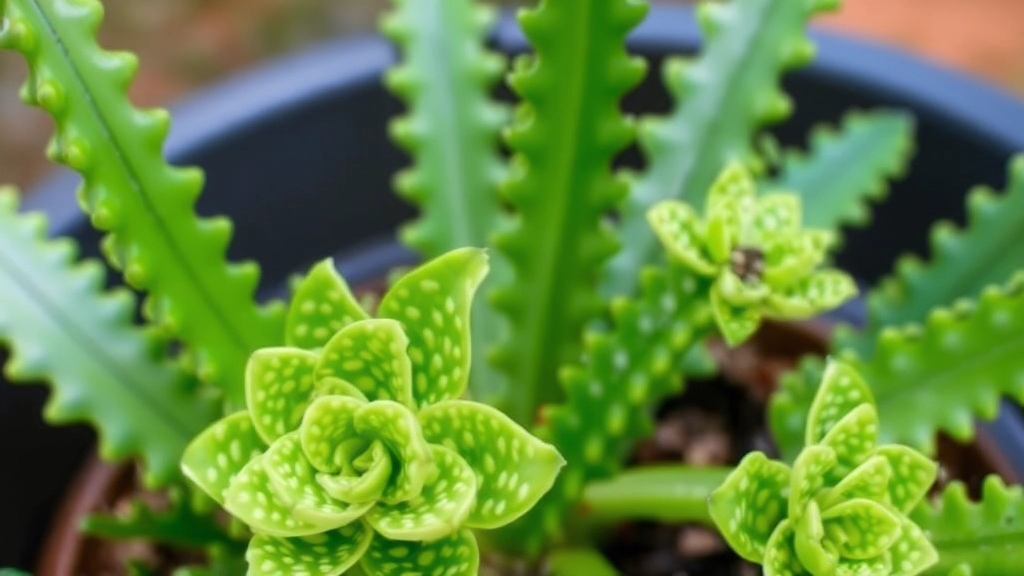
So, why should you consider adding the Leopard Mother Of Thousands (Kalanchoe Daigremontiana) to your plant collection?
Let’s dive into the perks!
1. Easy Care
First off, this plant is a breeze to look after.
- Low Maintenance: It thrives on neglect, making it perfect for busy folks.
- Drought Tolerant: You can skip watering for a while, and it won’t bat an eye.
2. Unique Aesthetic
The Leopard Mother Of Thousands isn’t just a pretty face.
- Striking Appearance: Those little plantlets that sprout along the edges? They’re a real conversation starter.
- Versatile Decor: Fits in any space, from modern to rustic.
3. Air Purification
Did you know this plant can help clean your air?
- Natural Filter: It absorbs toxins and releases oxygen, making your home healthier.
4. Propagation Fun
If you love sharing plants, this one’s for you.
- Easy to Propagate: Just snip off a leaf or a plantlet and stick it in soil. Voila! You’ve got a new plant.
5. Educational Opportunity
If you’ve got kids or are just curious yourself, this plant is a great learning tool.
- Growth Observations: Watch how it produces hundreds of little plants, sparking curiosity about nature.
6. Resilience
This plant can handle a bit of tough love.
- Survives in Various Conditions: Whether it’s a sunny windowsill or a slightly shady corner, it adapts well.
7. Eco-Friendly Choice
By choosing to grow this plant, you’re making a green choice.
- Sustainable Gardening: It’s a hardy plant that doesn’t require much water or resources.
Decorative Uses and Landscaping Ideas for Kalanchoe Daigremontiana
As we explore the decorative potential of Kalanchoe Daigremontiana, also known as the Alligator Plant, it’s important to consider how this unique succulent can enhance your living spaces.
Versatile Indoor Plant
Kalanchoe Daigremontiana thrives indoors, making it a fantastic choice for home decor.
- Table Centerpieces: Its striking leaves and cascading plantlets can serve as an eye-catching centerpiece on dining or coffee tables.
- Windowsills: Place it on windowsills to enjoy the sun while adding a touch of greenery to your home.
- Shelving Units: The plant’s unique shape and texture can create visual interest when placed on shelves.
Outdoor Landscaping Ideas
If you’re contemplating outdoor landscaping, Kalanchoe Daigremontiana can be an excellent addition.
- Rock Gardens: Its drought-tolerant nature makes it perfect for rock gardens, where it can thrive alongside other succulents.
- Borders and Edging: Use it as a border plant to define pathways or garden beds, adding a lush, vibrant touch.
- Container Gardens: Combine it with other succulents in decorative pots for a stunning display on patios or balconies.
Creative Combinations
Pairing Kalanchoe Daigremontiana with complementary plants can elevate your garden design.
- Succulent Arrangements: Combine it with varieties like Echeveria or Sedum for a diverse succulent garden.
- Herb Gardens: It can also coexist with herbs, providing a unique contrast in texture and form.
Seasonal Displays
Consider using Kalanchoe Daigremontiana for seasonal displays.
- Festive Arrangements: Incorporate it into holiday decorations for a fresh, green touch.
- Themed Gardens: Create themed gardens that change with the seasons, featuring this plant for year-round interest.
By thoughtfully incorporating Kalanchoe Daigremontiana into your indoor and outdoor spaces, you can create a visually appealing environment that showcases its unique beauty.
For more information on how to care for this unique plant, check out our guide on growing and caring for Kalanchoe Daigremontiana. Additionally, if you’re interested in other varieties, explore our comprehensive list of Kalanchoe species.
Troubleshooting Common Issues
So, you’ve got your Kalanchoe Daigremontiana, also known as the Alligator Plant, and everything seems to be going well. But then, out of nowhere, you notice some issues popping up. Don’t stress! Let’s tackle these common problems together.
Yellowing Leaves
What’s happening?
If you see those vibrant green leaves turning yellow, it could mean a few things.
- Overwatering: This is the most common culprit. Check if the soil is soggy.
- Nutrient Deficiency: Sometimes, your plant might be craving some food. A balanced fertiliser can help.
Dropping Leaves
Why is this happening?
Seeing leaves fall off can be alarming, but it’s often a sign of stress.
- Temperature Shock: If you’ve moved your plant to a colder area, it might react by shedding leaves.
- Underwatering: Make sure you’re keeping a consistent watering schedule.
Leggy Growth
What does it mean?
If your Alligator Plant is stretching out and looking leggy, it might be reaching for light.
- Insufficient Light: Move it closer to a bright window.
- Rotate the Plant: This encourages even growth on all sides.
Pests and Diseases
What should I look for?
Pests can sneak up on you, but being vigilant can save your plant.
- Mealybugs: Look for white, cottony spots. A cotton swab dipped in alcohol can help remove them.
- Fungal Issues: If you see spots on the leaves, it might be a fungal infection. Remove affected leaves and ensure proper air circulation. For more detailed solutions, check out how to treat Kalanchoe black spots.
Stem Rot
How do I know?
If the stem feels mushy or black, it’s likely suffering from rot.
- Check Your Watering: Make sure you’re not watering too frequently.
- Repotting: If the soil is too compact, consider repotting in fresh, well-draining soil. For more tips, refer to the complete care guide for Kalanchoe Daigremontiana.
FAQs about Leopard Mother Of Thousands (Kalanchoe Daigremontiana)
What are the common names for Kalanchoe Daigremontiana?
This plant is known by several names, including Leopard Mother Of Thousands, Alligator Plant, and Chandelier Plant. Its scientific name is Bryophyllum Daigremontianum.
What are the ideal growing conditions for Kalanchoe Daigremontiana?
This plant thrives in bright, indirect sunlight, warm temperatures between 20°C to 30°C (68°F to 86°F), and low humidity. It prefers well-draining soil, such as a cactus or succulent mix, and containers with drainage holes.
How often should I water my Alligator Plant?
Water your plant every 2-3 weeks during the growing season (spring and summer) and reduce to once a month in winter. Always check if the top inch of the soil is dry before watering again.
What are the common pests and diseases that affect this plant?
Common pests include mealybugs, aphids, spider mites, and scale insects. Diseases such as root rot, powdery mildew, and leaf spot can also affect the plant. Regular inspections and good airflow can help prevent these issues.
What are the benefits of growing Leopard Mother Of Thousands?
This plant is easy to care for, has a unique aesthetic, purifies the air, is fun to propagate, offers educational opportunities, is resilient, and is an eco-friendly choice for sustainable gardening.
How can I propagate Kalanchoe Daigremontiana?
Propagation is simple. Just snip off a leaf or a plantlet and stick it in soil. It will quickly grow into a new plant.
Why is it called the Mother of Thousands?
The name comes from its ability to produce countless tiny plantlets along the edges of its leaves, which can grow into new plants.
Can this plant survive in low light conditions?
While it prefers bright, indirect sunlight, it can adapt to slightly shady conditions, though its growth may be slower.
What should I do if my plant shows signs of overwatering?
Signs of overwatering include yellowing leaves and mushy stems. If this occurs, reduce the watering frequency and ensure the soil is well-draining.
Is Kalanchoe Daigremontiana safe for pets?
This plant can be toxic if ingested by pets. It’s best to keep it out of reach of cats, dogs, and other animals.
References
-
Growing Mother of Thousands Indoors
-
Kalanchoe Daigremontiana Care Guide
-
Mother of Thousands: Houseplants Expert
